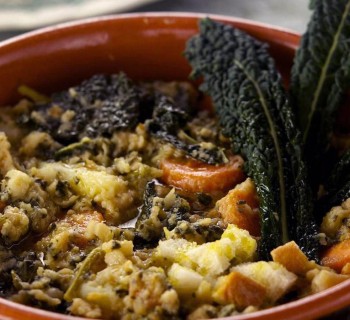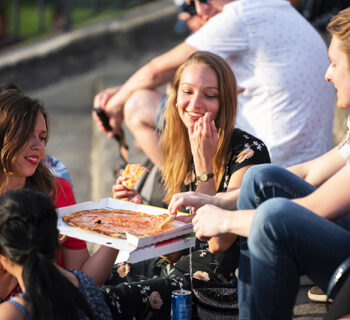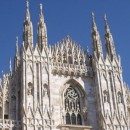Clicca qui per la versione in italiano
Today is Carbonara Day! So, pasta lovers unite because it’s time to celebrate this signature dish from the Eternal city's gastronomic traditions. According to Federico Fellini, “life is a combination of pasta and magic” and Carbonara is the perfect example because just five ingredients are enough to create a unique recipe that continues to conquer the palates of the world.
At the Scuola Leonardo da Vinci Rome, we believe that nothing engages all of your senses as richly as eating food. Eating is a full sensory experience that involves sight, smell, taste, touch. Even if Carbonara is very simple to make (it takes about 10 minutes), it is a dish that is luxurious and full of flavor due to its creamy and wonderfully rich texture.
For this reason, we recently organized a cooking class where students learned the secrets for cooking Carbonara, such as using the right meat, avoiding cream, vegetables, Parmigiano Reggiano cheese and using low or no heat. Italians have defined rules about traditional carbonara, and Romans especially can be very picky about the right ingredients.
As for the original ingredients or how the recipe was invented, there is an ongoing debate. Still, it is important to consider that Carbonara as a dish was unknown until the 1940s, and the first time it appeared in a book is in 1954, when an important Italian food magazine, La Cucina Italiana, published the recipe.
The most plausible theory says it was invented by charcoal burners who lived in the Apennine mountains. They used to prepare baskets with pecorino cheese and eggs in order to have a protein-rich meal during their workday. Another theory involving American soldiers during the second world war dates back to the early 1940s. According to this narrative, U.S. soldiers used bacon, eggs, and cheese to make pasta that reminded them of home.
Whatever its origin, one thing is certain: Carbonara has become a great classic of Italian traditional cuisine!
More articles about Italian traditions:
USEFUL LINKS
Read more articles about our excursions and cultural courses:
- Dolce Vita program in Rome
- The "Dolce Vita" course in Rome
- Learn & Go programs. Italian language and city tour
Carbonara, una ricetta della tradizione romana
Oggi è il giorno dedicato alla Pasta Carbonara, quindi amanti della pasta unitevi perché è tempo di celebrare la ricetta romana più desiderata, il piatto emblema della tradizione gastronomica della città eterna. Secondo Federico Fellini “la vita è una combinazione di pasta e magia” e la carbonara è il perfetto esempio perché solo cinque ingredienti sono sufficienti per creare una ricetta unica che continua a conquistare i palati del mondo.
Nella Scuola Leonardo da Vinci di Roma, crediamo fortemente che nulla coinvolga i sensi più pienamente che l’atto del mangiare. In generale, mangiare è un’esperienza sensoriale legata alla vista, all’olfatto, al gusto e al tatto. Pur essendo molto facile da preparare (richiede circa 10 minuti) la Carbonara è lussuriosa e sexy perché è cremosa meravigliosamente ricca e saziante, piena di sapore.
È proprio per questa ragione che la scorsa settimana la Scuola Leonardo da Vinci Roma ha organizzato una lezione di cucina in cui gli studenti hanno imparato tutte le fasi della preparazione di una deliziosa carbonara a partire dagli errori più comuni da evitare: usare solo guanciale, dimenticare ogni tipo di crema, evitare verdure, non mettere il parmigiano per nessuna ragione, stare lontani dai fornelli altrimenti diventa una frittata di spaghetti. Infatti, gli italiani hanno delle regole ben definite sulla carbonara e, in particolare a Roma, le persone possono essere puntigliose su queste.
Per quanto riguarda come la ricetta sia stata inventata a quali siano gli ingredienti autentici c’è un lungo dibattito ma è molto importante considerare che la carbonara era sconosciuta fino agli anni quaranta e la prima volta che è comparso un libro è stato nel 1954, quando la più famosa rivista culinaria italiana La Cucina Italiana ha pubblicato la ricetta.
Probabilmente, la teoria più accreditata riguarda i carbonai che vivevano nelle montagne dell’Appennino. Loro abitualmente riempivano i canestri con pecorino, uova e altri ingredienti al fine di avere pasti ricchi di proteine. Un’altra teoria risale ai primi anni quaranta del ventesimo secolo e si riferisce ai soldati americani nella seconda guerra mondiale. Secondo questa narrazione i soldati statunitensi usavano il bacon, le uova e il formaggio per preparare una pasta che ricordasse loro i sapori familiari.
Qualunque siano le sue origini, una cosa è certa: la Carbonara è diventata un grande classico della tradizione culinaria italiana!
Altri articoli sulle tradizioni italiane:
LINK UTILI:
Scuola Leonardo da Vinci Rome
The Eternal City has known it all. Victory and defeat, joy and tragedy, glory and humility marked Rome’s history, culture and architecture. A magical place with vibrant, timeless lifestyle with countless secrets waiting to be discovered.
The Scuola Leonardo da Vinci is situated in the centre of Rome, in the pedestrian area, halfway from the astounding Piazza Navona, Castel S. Angelo and St. Peter Basilica. It is one of the largest schools in Rome.
We, from Leonardo da Vinci School have one mission – to introduce you to this exciting urban symphony. Every year thousand of students from more than 90 countries jump into this adventure hand in hand with us. Leonardo da Vinci School is not only leading language institute, but centre of Italian culture and lifestyle. We match our vast experience with our student’ eagerness to know and learn and together we make it happen.
Latest posts by Scuola Leonardo da Vinci Rome (see all)
- Raffaella Carrà: From "Queen of Television" - July 9, 2024
- Rome Pride: your love is as eternal as Rome - June 13, 2024
- Sakura: From the Rising Sun to Rome! - April 16, 2024









